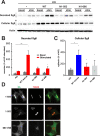Identification of the functional domain of the dense core vesicle biogenesis factor HID-1
- PMID: 37751424
- PMCID: PMC10522040
- DOI: 10.1371/journal.pone.0291977
Identification of the functional domain of the dense core vesicle biogenesis factor HID-1
Abstract
Large dense core vesicles (LDCVs) mediate the regulated release of neuropeptides and peptide hormones. HID-1 is a trans-Golgi network (TGN) localized peripheral membrane protein contributing to LDCV formation. There is no information about HID-1 structure or domain architecture, and thus it remains unknown how HID-1 binds to the TGN and performs its function. We report that the N-terminus of HID-1 mediates membrane binding through a myristoyl group with a polybasic amino acid patch but lacks specificity for the TGN. In addition, we show that the C-terminus serves as the functional domain. Indeed, this isolated domain, when tethered to the TGN, can rescue the neuroendocrine secretion and sorting defects observed in HID-1 KO cells. Finally, we report that a point mutation within that domain, identified in patients with endocrine and neurological deficits, leads to loss of function.
Copyright: © 2023 Hummer et al. This is an open access article distributed under the terms of the Creative Commons Attribution License, which permits unrestricted use, distribution, and reproduction in any medium, provided the original author and source are credited.
Conflict of interest statement
The authors declare that the research was conducted in the absence of any commercial or financial relationships that could be construed as a potential conflict of interest. This does not alter our adherence to PLOS ONE policies on sharing data and materials.
Figures





Similar articles
-
HID-1 controls formation of large dense core vesicles by influencing cargo sorting and trans-Golgi network acidification.Mol Biol Cell. 2017 Dec 15;28(26):3870-3880. doi: 10.1091/mbc.E17-08-0491. Epub 2017 Oct 26. Mol Biol Cell. 2017. PMID: 29074564 Free PMC article.
-
Secretory granule biogenesis and neuropeptide sorting to the regulated secretory pathway in neuroendocrine cells.J Mol Neurosci. 2004;22(1-2):63-71. doi: 10.1385/JMN:22:1-2:63. J Mol Neurosci. 2004. PMID: 14742911
-
Tuning the Size of Large Dense-Core Vesicles and Quantal Neurotransmitter Release via Secretogranin II Liquid-Liquid Phase Separation.Adv Sci (Weinh). 2022 Sep;9(27):e2202263. doi: 10.1002/advs.202202263. Epub 2022 Jul 27. Adv Sci (Weinh). 2022. PMID: 35896896 Free PMC article.
-
Biogenesis of secretory granules in the trans-Golgi network of neuroendocrine and endocrine cells.Biochim Biophys Acta. 1998 Aug 14;1404(1-2):231-44. doi: 10.1016/s0167-4889(98)00059-7. Biochim Biophys Acta. 1998. PMID: 9714820 Free PMC article. Review.
-
Calcium-sensing beyond neurotransmitters: functions of synaptotagmins in neuroendocrine and endocrine secretion.Biosci Rep. 2009 Aug;29(4):245-59. doi: 10.1042/BSR20090031. Biosci Rep. 2009. PMID: 19500075 Review.
References
Publication types
MeSH terms
Substances
Grants and funding
LinkOut - more resources
Full Text Sources
Research Materials
Miscellaneous

